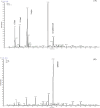Comparison of phytochemical properties and expressional profiling of artemisinin synthesis-related genes in various Artemisia species
- PMID: 38439855
- PMCID: PMC10909637
- DOI: 10.1016/j.heliyon.2024.e26388
Comparison of phytochemical properties and expressional profiling of artemisinin synthesis-related genes in various Artemisia species
Abstract
The Artemisia genus belongs to the Asteraceae family and is used in the treatment of many different diseases such as hepatitis and cancer. So far, around 500 species of Artemisia have been found in different regions of the world. Artemisinin is one of the medicinal compounds found in Artemisia species. Hence, this medical feature encourages researchers to pay attention to various species of this genus to discover more genetic and phytochemical information. In the present study, five species of Artemisia including A. fragrans, A. annua, A. biennis, A. scoparia, and A. absinthium were compared to each other in terms of the artemisinin content and other phytochemical components. Moreover, the relative expression profiles of eight genes related to the accumulation and synthesis of artemisinin [including 4FPSF, DBR2, HMGR1, HMGR2, WIRKY, ADS, DXS, and SQS] were determined in investigated species. The result of high-performance liquid chromatography (HPLC) analysis showed that the content of artemisinin in various species was in the order of A. fragrans > A. annua > A. biennis > A. scoparia > A. absinthium. Based on the gas chromatography-mass spectrometry (GC-MS) analysis, 34, 26, 26, 24, and 20 phytochemical compounds were identified for A. scoparia, A. biennis, A. fragrans, A. absinthum, and A. annua species, respectively. Moreover, camphor (38.86%), β-thujone (68.42%), spathulenol (48.33%), β-farnesene (48.16%), and camphor (29.04%) were identified as the considerable compounds A. fragrans, A. absinthium, A. scoparia, A. biennis, and A. annua species, respectively. Considering the relative expression of the targeted genes, A. scoparia revealed higher expression for the 4FPSF gene. The highest relative expression of the DBR2, WIRKY, and SQS genes was found in A. absinthium species. Moreover, A. annua showed the highest expression of the ADS and DXS genes than the other species. In conclusion, our findings revealed that various species of Artemisia have interesting breeding potential for further investigation of different aspects such as medicinal properties and molecular studies.
Keywords: Artemisia; Artemisinin; Chromatography; Gene expression; Medicinal plants.
© 2024 The Authors.
Conflict of interest statement
The authors declare that they have no known competing financial interests or personal relationships that could have appeared to influence the work reported in this paper.
Figures







References
-
- Badr A., El-Shazly H.H., Helail N.S., Ghanim W. Genetic diversity of Artemisia populations in central and north Saudi Arabia based on morphological variation and RAPD polymorphism. Plant Systemat. Evol. 2012;298:871–886.
-
- Willcox M. Artemisia species: from traditional medicines to modern antimalarials-and back again. J. Alternative Compl. Med. 2009;15:101–109. - PubMed
LinkOut - more resources
Full Text Sources
Miscellaneous

